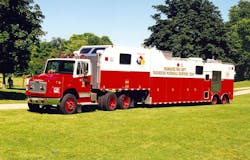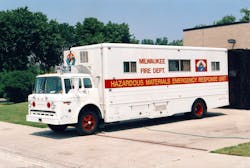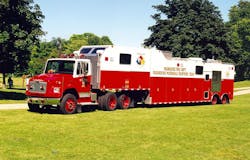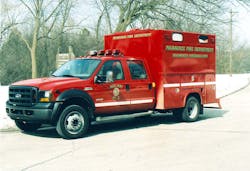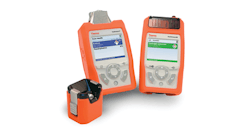Milwaukee is the largest city in Wisconsin and the fifth largest in the Midwest. It is the seat of Eponymous County and lies on the western shore of Lake Michigan. The city’s estimated population in 2017 was 595,351 in a geographical area of 96.84 square miles. Milwaukee is the main cultural and economic center of the Milwaukee metropolitan area, which has an estimated population of 2,043, 904. The metro area is the second most densely populated area in the Midwest, surpassed only by Chicago.
Fire department history
In 1837, a volunteer fire department was formed in Milwaukee. As the city grew, so did the fire department, eventually boasting eight hand-drawn engines, two hook and ladder companies and two hose companies. The first steam engine was purchased in 1861. The new engine required an engineer to operate so a career firefighter was hired. During the advent of the steam engine and the onset of the Civil War, the volunteer organization was replaced with a career department. A full-time department began on Jan. 1, 1875.
Today’s department
Chief Mark Rohlfing was the first chief hired from outside the Milwaukee Fire Department (MFD) on May 3, 2010. Rohlfing spent most of his 27-year career as chief of the Omaha, NE, Fire Department. From Omaha he went to Rapid City, SD, for 2½ years before coming to Milwaukee. I had the pleasure of meeting Rohlfing while he was in Rapid City when I visited that city’s hazmat team in 2009.
Under Rohlfing's leadership are 900 uniformed personnel providing service from 30 fire stations. The MFD is organized into five battalions and one deputy chief who is the shift commander. Firefighters operate 30 engines, eight trucks, two rescues, 12 ALS medic units and three hazmat vehicles. Other apparatus include a Heavy Urban Rescue Team, Dive Rescue Team, Fire Investigation Unit, Tactical EMS, and Incident Command Unit with a drone.
Engine companies are staffed with four personnel. Truck companies are staffed with four as well, except Truck 1 (Dive Team) and Truck 16 (Hazmat), each staffed with five members.
A fireboat operates from April through November and is staffed by Engine 1.Hazmat team history
The MFD established a unit that responded to petroleum spills before the advent of organized hazmat response as we know it today. During 1966, the MFD Repair Shop converted a spare pumper into the Petroleum Dispersal Unit. This unit carried an electric oil skimmer and oil boom for use in the Port of Milwaukee and local rivers. This unit remained in operation until 1989. The functions of the unit were taken over by the Hazmat Team.
Milwaukee's Hazmat Response Team was organized in 1980 with seven team members operating out of a station wagon assigned to the training academy's battalion chief. Their first hazmat unit was a 1973 Grumman-Cortex (1983–1987) previously used as a Navy recruiting van. The next vehicle was a 1980 Ford-Medicoach (1987–1995) previously used as a blood collection vehicle.
Modern-day Hazmat Team
Milwaukee's Hazmat Team is housed at Station 33, located at 4515 W. Burnham St., in the village of West Milwaukee. Since 1991, Milwaukee has provided fire protection under contract to the Village of West Milwaukee. Apparatus housed at Station 33 includes Engine 33, Truck 16, Hazmat 1 and Hazmat 2.Hazmat 1 is a 1997 Freightliner tractor with a Marion trailer heavy-duty rescue body (scheduled for replacement in 2020). Hazmat 2 is a 2007 Ford F-350 four-door cab with Knapheide utility box (pulls decontamination trailer).
The Canadian Pacific Railroad has loaned a foam trailer to the MFD for use at Bakken crude oil train derailments. It carries 275 gallons of 3 percent alcohol-resistant aqueous film forming foam (AR AFFF) and features a 750-gpm portable pump, a 10,000-gallon portable water tank, and foam nozzles and fittings. The foam trailer is housed at Station 33.
Engine companies carry a 5-gallon bucket of dry clay absorbent as well as a 5-gallon bucket of industrial detergent. Hazmat 2 responds to fuel spills of less than 25 gallons, while Hazmat 1 responds to spills greater than 25 gallons.
Twenty-five hazmat techs are on duty city-wide. Nine are at Station 33, four on the engine and five on the truck. There are 80 technicians on the MFD. The Hazmat Team is not dedicated; crews from Engine 33 and Truck 16 provide staffing for the hazmat units when needed.
If mutual aid is required, it is available from Tier II Teams in the City of Racine and City of Madison and Tier III Teams in Washington County and Sheboygan County. The Tier I Team has more training and monitoring equipment in radiation and terrorism. The Tier II Team (formally called Level A) can make Level A entries. The Tier III Teams are generally county teams that will handle fuel spills and some identification of unknowns, but not much actual mitigation.A full hazmat response gets three engines, two trucks, one rescue, one medic, one safety officer, two battalion chiefs, plus Hazmat 1 and Hazmat 2. There is also a limited response where only the first-due engine, ladder, medic unit, battalion chief, and hazmat unit respond.
Response area hazards
Transportation routes include Interstates 94 and 43; the Canadian National, Canadian Pacific, Union Pacific and Wisconsin Southern railroads; the Port of Milwaukee; the Kinnickinnic, Menomonee and Milwaukee Rivers and tributaries; and the Mitchell International Airport. Fixed facilities include Miller Brewery, which has large amounts of anhydrous ammonia. Mateion Chemical Company manufacturers various chemicals.
PPE, equipment and training
Hazmat team members use Level A Kappler Suits; Level B suits are Tyvek coveralls. Respiratory protection is provided by MSA SCBA with 1-hour bottles and positive-pressure air purifying respirators (PAPRs). In-suit communications are though portable radios operating on an analog channel.
Monitoring and detection equipment includes:
· From RAE Systems, four AreaRAE units, one with gamma detection; four MultiRAE units, two with hydrogen sulfide, one with anhydrous ammonia and one with chlorine gas; two QRAE four-gas monitors; four ToxiRAE monitors that detect carbon dioxide, sulfur dioxide, anhydrous ammonia and hydrogen cyanide; and two MiniRAE units
· From ThermoFisher Scientific, one FirstDefender RMX S1 and one TruDefender FTX
· One Canberra ADM-300 survey meter
· Two Ludlum Measurements Model 14C general survey meters
· One Polimaster Model PM1703GNB radiation detector
· Four S.E. International Inspector RAD radiation detectors
· Two NukAlert units
· One FLIR identiFINDER R100
· One Honeywell sensor for anhydrous ammonia and chlorine gas
· One Environics ChemPro 100i radiation detector
· One Extech Model 42545 infrared thermometer
· One Raytek temperature gun
· From Robinair, one TIF8900 combustible gas detector and one TIF XP-1A refrigerant leak detector
· One Jerome J405 mercury detector
· Dräger tubes
· One Mistral Security DropEx explosive detection kit
· One Biowarfare Agent Detection Device (BADD kit)
Basic CO detectors are carried on engines and trucks. Battalion chiefs carry more advanced CO detectors.
Training for technicians includes the 80-hour IAFF Technician Class. Firefighters are trained to the Operations level utilizing the IAFF HazMat Operations Class. Canadian Pacific Railroad has provided on loan a training trailer for use in training on valves and hardware associated with railroad tank cars as well.
Reference resources
· ERDSS Chemical Companion software
· NOAA’s CAMEO (Computer-Aided Management of Emergency Operations) software suite, including MARPLOT (Mapping Application for Response, Planning, and Local Operational Tasks) and ALOHA hazard-modeling program
· NIH’s WISER (Wireless Information System for Emergency Responders) software
· Goldfrank’s Toxicologic Emergencies
· NIOSH Pocket Guide to Chemical Hazards
· Guardian Plume, plume-tracking by ProRAE Guardian
· Sigma-Aldrich safety data sheets
For more
The MFD as a rich history, which has been carefully recorded by the Milwaukee Fire Historical Society. For additional information, contact Captain Daniel Rode at [email protected]. For historical information about the MFD, contact Deputy Chief (ret.) James Ley with the Milwaukee Fire Historical Society at [email protected].
Sidebar: Historic incidents
Schwab Stamp & Seal Acid Spill
On Feb. 4, 1903, an acid carboy broke open on the second floor of the Schwab Stamp & Seal Company facility. Employees scattered after calling the fire department. A leaking carboy of nitric acid leaked, creating corrosive and toxic vapors.
Cleaning the mess was only a salvage job for the trucks and insurance patrol. Other companies were sent home. Chief of Department James Foley and Trucks 1 and 2 located the leaking carboy and carried it outside. Then companies spent time scattering saw dust on the floor, raking it up and tossing it outside.
After venting the building, Captain Andrew White of Truck 1 became ill. During the next few hours, man after man complained of choking. White died that night. Foley fell ill and remarked, “I’ll bet $100 that I'll be dead by morning.” He died at 4:15 a.m. Thomas Droney of Chemical 1 had responded to another alarm earlier in the day. While there he collapsed in the snow. Revived, he went back to the firehouse where, within a short time, he also died. The fumes had seared the men's lungs, dooming them to slow suffocation.
Several firefighters died in the incident:
· James Foley, Chief of Department
· Andrew White, Captain, Truck 1
· Edward Hogan, Pipeman, Engine 1
· Thomas Droney, Pipeman, Engine 1
Several more were injured:
· Daniel McCarthy, Truckman, Engine 1
· Thomas Clancy, Assistant Chief
· Peter Lancaster, Captain Truck 2
· William Meloy, Truckman
· George Hanrahan, Truckman
· William Kennedy, Truckman
· John Linehan, Truckman
· Joseph Nunwash, Truckman
· George Ryan, Truckman
· Jack J. Hennessey, Lieutenant
Marsh Wood Products
On April 20, 1926, a fire occurred at Marsh Wood Products. A small fire got started in the boiler room where a huge bin held tons of sawdust used for fuel. Engines 14, 3, 19, 20, Fireboat 15, Trucks 8 and 4 and District Chiefs 3 and 4 responded. Only a few employees were in the plant at the time. Although no fire was showing when companies arrived, there was a thin haze of smoke and several sprinkler heads were operating.
Engine 14 and Truck 8 dug through the smoldering sawdust looking for sparks. Then a blinding flash occurred. Something had ignited the aerosolized sawdust, causing a massive explosion. A dozen men were afire from head to toe and ran and stumbled from the building. They were screaming and writhing in pain.
Engine 3 crewmembers who had been outside picking up their line went to help their brothers. A third alarm was sent in. Engine 14 and Truck 8 were wiped out.
Several firefighters died in the incident:
· John Skorzewski, Captain, Truck 8
· Al Schultz, Truck 8
· Tom Hanlon, Lieutenant, Engine 14
· Ambrose Skorzewski, Pipeman, Engine 14
· Stanley Strezeminski, Engine 14
· George Liefert, Engine 14
At least 9 others were hospitalized.
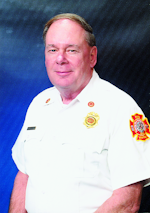
Robert Burke
ROBERT BURKE, who is a hazardous materials and fire protection consultant and a Firehouse contributing editor, is a Certified Fire Protection Specialist (CFSP), Fire Inspector II, Fire Inspector III, Fire Investigator and Hazardous Materials Specialist. He has served on state and county hazmat teams. Burke is the author of the textbooks "Hazardous Materials Chemistry for Emergency Responders," "Counter-Terrorism for Emergency Responders," "Fire Protection: Systems and Response," "Hazmat Teams Across America" and "Hazmatology: The Science of Hazardous Materials." He can be contacted at [email protected].
